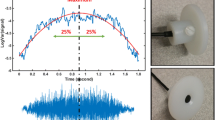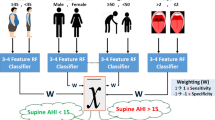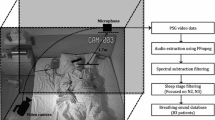Abstract
Obstructive sleep apnea (OSA) is a prevalent health problem. Developing a technology for quick OSA screening is momentous. In this study, we used regularized logistic regression to predict the OSA severity level of 199 individuals (116 males) with apnea/hypopnea index (AHI) ≥ 15 (moderate/severe OSA) and AHI < 5 (non-OSA) using their tracheal breathing sounds (TBS) recorded during daytime, while they were awake. The participants were guided to breathe through their nose, and then through their mouth at their deep breathing rate. The least absolute shrinkage and selection operator (LASSO) feature selection approach was used to select the discriminative features from the power spectra of the TBS and the anthropometric information. Using a five-fold cross-validation procedure, five different training sets and their corresponding blind-testing sets were formed. The average blind-testing classification accuracy over the five different folds was found to be 79.3% ± 6.1 with the sensitivity (specificity) of 82.2% ± 7.2% (75.8% ± 9.9%). The accuracy for the entire dataset was found to be 81.1% with sensitivity (specificity) of 84.4% (77.0%). The feature selection and classification procedures were intelligible and fast. The selected features were physiologically meaningful. Overall, the results show that TBS analysis can be used as a quick and reliable prediction of the presence and severity of OSA during wakefulness without a sleep study.

Wakefulness screening of obstructive sleep apnea using tracheal breathing sounds and anthropometric information by means of regularized logistic regression with the least absolute shrinkage and selection operator approach for feature selection and classification.






Similar content being viewed by others
References
Malhotra A, White DP (2002) Obstructive sleep apnoea. Lancet 360:237–245. https://doi.org/10.1016/S0140-6736(02)09464-3
Eckert DJ, Younes MK (2014) Arousal from sleep: implications for obstructive sleep apnea pathogenesis and treatment. J Appl Physiol 116:302–313. https://doi.org/10.1152/japplphysiol.00649.2013
Young T, Palta M, Dempsey J et al (2010) Burden of sleep apnea: rationale, design, and major findings of the Wisconsin Sleep Cohort Study. WMJ Off Publ State Med Soc Wisconsin 108:246–249
Senaratna CV, Perret JL, Lodge CJ et al (2017) Prevalence of obstructive sleep apnea in the general population: a systematic review. Sleep Med Rev 34:70–81. https://doi.org/10.1016/j.smrv.2016.07.002
Memtsoudis SG, Besculides MC, Mazumdar M (2013) A rude awakening — the perioperative sleep apnea epidemic. N Engl J Med 368:2352–2353. https://doi.org/10.1056/NEJMp1302941
Sullivan F (2016) Hidden health crisis costing america billions. Underdiagnosing and Undertreating Obstructive Sleep Apnea Draining Healthcare System
Kushida CA, Littner MR, Morgenthaler T, Alessi CA, Bailey D, Coleman J Jr, Friedman L, Hirshkowitz M, Kapen S, Kramer M, Lee-Chiong T, Loube DL, Owens J, Pancer JP, Wise M (2005) Practice parameters for the indications for polysomnography and related procedures: an update for 2005. Sleep 28:499–523. https://doi.org/10.1093/sleep/28.4.499
Chiu HY, Chen PY, Chuang LP, Chen NH, Tu YK, Hsieh YJ, Wang YC, Guilleminault C (2017) Diagnostic accuracy of the Berlin questionnaire, STOP-BANG, STOP, and Epworth sleepiness scale in detecting obstructive sleep apnea: a bivariate meta-analysis. Sleep Med Rev 36:57–70. https://doi.org/10.1016/j.smrv.2016.10.004
Young T, Shahar E, Nieto J et al (2002) Predictors of Sleep-disordered breathing in community-dwelling adults: the Sleep Heart Health Study. Arch Intern Med 162:893–900. https://doi.org/10.1001/archinte.162.8.893
Elwali A, Moussavi Z (2017) Obstructive sleep apnea screening and airway structure characterization during wakefulness using tracheal breathing sounds. Ann Biomed Eng 45:839–850. https://doi.org/10.1007/s10439-016-1720-5
Montazeri A, Giannouli E, Moussavi Z (2012) Assessment of Obstructive sleep apnea and its severity during wakefulness. Ann Biomed Eng 40:916–924. https://doi.org/10.1007/s10439-011-0456-5
Sola-Soler J, Fiz JA, Torres A, Jane R (2014) Identification of obstructive sleep apnea patients from tracheal breath sound analysis during wakefulness in polysomnographic studies. Conf Proc Annu Int Conf IEEE Eng Med Biol Soc IEEE Eng Med Biol Soc Annu Conf 2014:4232–4235. https://doi.org/10.1109/EMBC.2014.6944558
Yadollahi A, Montazeri A, Azarbarzin A, Moussavi Z (2013) Respiratory flow–sound relationship during both wakefulness and sleep and its variation in relation to sleep apnea. Ann Biomed Eng 41:537–546. https://doi.org/10.1007/s10439-012-0692-3
Yadollahi A, Moussavi ZMK (2007) Acoustical flow estimation: review and validation. IEEE Eng Med Biol Mag 26:56–61. https://doi.org/10.1109/MEMB.2007.289122
Wang Y, Mcdonald JP, Liu Y et al (2014) Dynamic alterations of the tongue in obstructive sleep apnea-hypopnea syndrome during sleep: analysis using ultrafast MRI. Genet Mol Res 13:4552–4563. https://doi.org/10.4238/2014.June.17.7
Wu Z, Chen W, Khoo MCK, Davidson Ward SL, Nayak KS (2016) Evaluation of upper airway collapsibility using real-time MRI. J Magn Reson Imaging 44:158–167. https://doi.org/10.1002/jmri.25133
Barkdull GC, Kohl C, Patel M, Davidson TM (2008) Computed tomography imaging of patients with obstructive sleep apnea. Laryngoscope 118:1486–1492. https://doi.org/10.1097/MLG.0b013e3181782706
Liu K-H, Chu WCW, To K-W et al (2007) Sonographic measurement of lateral parapharyngeal wall thickness in patients with obstructive sleep apnea. J Sleep 30:1503–1508
Schwab RJ, Pasirstein M, Pierson R, Mackley A, Hachadoorian R, Arens R, Maislin G, Pack AI (2003) Identification of upper airway anatomic risk factors for obstructive sleep apnea with volumetric magnetic resonance imaging. Am J Respir Crit Care Med 168:522–530. https://doi.org/10.1164/rccm.200208-866OC
Finkelstein Y, Wolf L, Nachmani A, Lipowezky U, Rub M, Shemer S, Berger G (2014) Velopharyngeal anatomy in patients with obstructive sleep apnea versus normal subjects. J Oral Maxillofac Surg 72:1350–1372. https://doi.org/10.1016/j.joms.2013.12.006
Tibshirani R (2011) Regression shrinkage and selection via the lasso: a retrospective. J R Stat Soc Ser B (Statistical Methodol) 73:273–282. https://doi.org/10.1111/j.1467-9868.2011.00771.x
Hastie T, Tibshirani R, Friedman J (2009) The Elements of Statistical Learnin
Goldstein BA, Navar AM, Carter RE (2017) Moving beyond regression techniques in cardiovascular risk prediction: applying machine learning to address analytic challenges. Eur Heart J 38:1805–1814. https://doi.org/10.1093/eurheartj/ehw302
Wen Y, Pi FH, Guo P et al (2016) Sleep duration, daytime napping, markers of obstructive sleep apnea and stroke in a population of southern China. Sci Rep 6:1–9. https://doi.org/10.1038/srep34689
Oulhaj A, Al Dhaheri S, Bin SB, Al-Houqani M (2017) Discriminating between positional and non-positional obstructive sleep apnea using some clinical characteristics. Sleep Breath 21:877–884. https://doi.org/10.1007/s11325-017-1499-0
Arvin F, Doraisamy S, Safar Khorasani E (2011) Frequency shifting approach towards textual transcription of heartbeat sounds. Biol Proced Online 13:1–7. https://doi.org/10.1186/1480-9222-13-7
Pasterkamp H, Kraman SS, Wodicka GR (1997) Respiratory sounds, advances beyond the stethoscope. Am J Respir Crit Care Med 156:974–987
Hajipour F, Moussavi Z (2018) Spectral and higher order statistical characteristics of expiratory tracheal breathing sounds during wakefulness and sleep in people with different levels of obstructive sleep apnea. J Med Biol Eng 1–7. https://doi.org/10.1007/s40846-018-0409-7
Proakis JG, Manolakis DG (1996) Digital signal processing
Simes RJ (1986) An improved Bonferroni procedure for multiple tests of significance. Biometrika 73:751–754. https://doi.org/10.1093/biomet/73.3.751
Šidák Z (1971) On probabilities of rectangles in multivariate Student distributions: their dependence on correlations. Ann Math Stat:169–175. https://doi.org/10.1214/aoms/1177693504
Hastie T, Tibshirani R, Wainwright M (2015) Statistical learning with sparsity: the Lasso and generalizations
Sanchez I, Pasterkamp H (1993) Tracheal sound spectra depend on body height. Am Rev Respir Dis 148:1083–1087. https://doi.org/10.1164/ajrccm/148.4_Pt_1.1083
Epstein LJ, Kristo D, Strollo PJ et al (2009) Clinical guideline for the evaluation, management and long-term care of obstructive sleep apnea in adults. J Clin Sleep Med 5:263–276
Alshaer H, Pandya A, Bradley TD, Rudzicz F (2014) Subject independent identification of breath sounds components using multiple classifiers. ICASSP, IEEE Int Conf Acoust Speech Signal Process - Proc 3577–3581. https://doi.org/10.1109/ICASSP.2014.6854267
Huq S, Moussavi Z (2012) Acoustic breath-phase detection using tracheal breath sounds. Med Biol Eng Comput 50:297–308. https://doi.org/10.1007/s11517-012-0869-9
Young T, Skatrud J, Peppard PE (2004) Risk factors for obstructive sleep apnea. 291:2013–2016
Schwartz AR, Patil SP, Laffan AM, Polotsky V, Schneider H, Smith PL (2008) Obesity and Obstructive sleep apnea: pathogenic mechanisms and therapeutic approaches. Proc Am Thorac Soc 5:185–192. https://doi.org/10.1513/pats.200708-137MG
Davies RJ, Stradling JR (1990) The relationship between neck circumference, radiographic pharyngeal anatomy, and the obstructive sleep apnoea syndrome. Eur Respir J Off J Eur Soc Clin Respir Physiol 3:509–514
Davies RJ, Ali NJ, Stradling JR (1992) Neck circumference and other clinical features in the diagnosis of the obstructive sleep apnoea syndrome. Thorax 47:101–105. https://doi.org/10.1136/thx.47.2.101
Eckert DJ, White DP, Jordan AS, Malhotra A, Wellman A (2013) Defining phenotypic causes of obstructive sleep apnea: identification of novel therapeutic targets. Am J Respir Crit Care Med 188:996–1004. https://doi.org/10.1164/rccm.201303-0448OC
Schwab RJ, Gupta KB, Gefter WB, Metzger LJ, Hoffman EA, Pack AI (1995) Upper airway and soft tissue anatomy in normal subjects and patients with sleep-disordered breathing. Significance of the lateral pharyngeal walls. Am J Respir Crit Care Med 152:1673–1689
Haponik EF, Smith PL, Bohlman ME, Allen RP, Goldman SM, Bleecker ER (1983) Computerized tomography in obstructive sleep apnea. Correlation of airway size with physiology during sleep and wakefulness. Am Rev Respir Dis 127:221–226. https://doi.org/10.1164/arrd.1983.127.2.221
von Helmholtz H (1860) Theorie der Luftschwingungen in Röhren mit offenen Enden. J für die reine und Angew Math 57:1–72
Veldi, Vasar, Vain et al (2000) Computerized endopharyngeal myotonometry (CEM): a new method to evaluate the tissue tone of the soft palate in patients with obstructive sleep apnoea syndrome. J Sleep Res 9:279–284. https://doi.org/10.1046/j.1365-2869.2000.00208.x
Author information
Authors and Affiliations
Corresponding author
Additional information
Publisher’s note
Springer Nature remains neutral with regard to jurisdictional claims in published maps and institutional affiliations.
Appendix 1. Classification using simple logistic regression
Appendix 1. Classification using simple logistic regression
In this study, as we had 2 classes of participants (non-OSA and moderate/severe OSA). Thus, we also applied the binomial logistic regression classifier to the features selected by the LASSO penalized logistic regression for classification purpose. The classification of the entire 164 non-OSA and moderate/severe participants showed 80.5% accuracy with sensitivity and specificity of 82.2% and 78.4%, respectively. The average of the results between the 5 training sets showed accuracies of 82.0% ± 1.8% and 78.1% ± 7.7% for training and testing, respectively. The sensitivity (specificity) was 83.0% ± 3.1% (80.8% ± 2.2%) for training and 78.9% ± 11.4% (77.1% ± 9.9%) for testing, respectively. The AUC, associated with ROC curve calculated using all non-OSA and moderate/severe participants, was shown to be 80.3. In addition, the average of the AUC values between the 5 training sets was shown to be 81.9 ± 1.7. For the dataset containing all 164 non-OSA and moderate/severe OSA participants, 32 were misclassified, out of which, 16 were from non-OSA and 16 were from moderate/severe OSA group. In addition, 17 out of 35 subjects in the gap range were assigned to the non-OSA group and the remaining 18 subjects to the moderate/severe group.
The reason for achieving the better result for regularized logistic regression classification than the simple logistic regression is that as there is still some correlation between the selected features, the regularization term can improve the generalization performance (performance on new data) by reducing the variance of parameter estimates.
1.1 Appendix 2. Computational complexities
The computation cost of our proposed algorithm is relatively low. For the feature extraction part, the computational cost was estimated for a typical TBS with length N after normalization. The feature extraction phase consisted of 2 main parts: LogVar estimation and PSD estimation. The LogVar and PSD calculated for each segment, defined as the window with length L which moves along the signal with 50% overlap. Thus, the total number of overlapping windows within each TBS is approximately\( \frac{2N}{L} \) . The computational cost of calculating LogVar within one segment is L; thus, the total number of operations to calculate the LogVar of each TBS is as follows:
For the PSD estimation, the fast Fourier transform (FFT) of each segment was calculated and averaged. The computational cost of calculating FFT of each segment is L log(L); thus, the total cost of PSD estimation for each TBS is as follows:
The feature extraction part is from O(k),where K is the number of extracted features from each TBS signal. As we have 16 signals for each participant (for mouth/nose breathing maneuvers, inspiratory/expiratory phases, summation/subtraction of phases, and normal/logarithmic scale), therefore, the total cost of feature extraction from n participant is as follows:
Feature reduction part of this study consists of applying t test and LASSO. As each t test has the computational cost of O(n), therefore, the overall t tests for all p features have the computational cost of p × O(n). On the other hand, in this study, we ran the LASSO with the Glmnet package of R, which uses the coordinate descent algorithm to find the optimum solution. The computational cost of this method is reported to be O(pn) for each iteration of the optimization [32]. Besides, as three features were selected as the best feature set of each training set, thus, the computational cost of logistic regression classification using the LASSO penalty is O(3n). Therefore, the total computational cost of our proposed method can be written as follows:
which is linear in terms of n, p.
Glossary
- AHI
-
Apnea/hypopnea index
- AUC
-
Area under the curve
- CI
-
Confidence interval
- FFT
-
Fast Fourier transform
- LASSO
-
Least absolute shrinkage and selection operator
- LogVar
-
Logarithm of the sound’s variance
- MANOVA
-
Multivariate analysis of variance
- OSA
-
Obstructive sleep apnea
- PSD
-
Power spectrum density
- PSG
-
Polysomnography
- ROC
-
Receiver operating characteristic
- SaO2
-
Oxygen saturation level of blood
- SVM
-
Support vector machine
- TBS
-
Tracheal breathing sounds
- UA
-
Upper airway
Rights and permissions
About this article
Cite this article
Hajipour, F., Jozani, M.J., Elwali, A. et al. Regularized logistic regression for obstructive sleep apnea screening during wakefulness using daytime tracheal breathing sounds and anthropometric information. Med Biol Eng Comput 57, 2641–2655 (2019). https://doi.org/10.1007/s11517-019-02052-4
Received:
Accepted:
Published:
Issue Date:
DOI: https://doi.org/10.1007/s11517-019-02052-4




